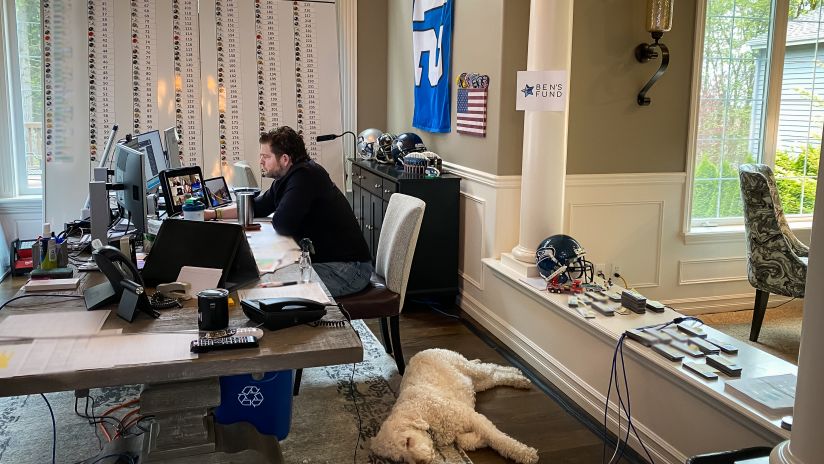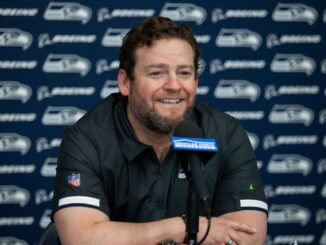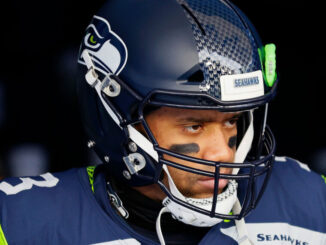
In the aftermath of the 2020 NFL draft, you’ve probably seen one of the many “draft grades” from industry experts evaluating each team’s results. These lists try to tell us which team did the best in the draft, and then 32 spots later, who did the worst.
In recent seasons, the Seattle Seahawks have fared poorly on these kinds of post-draft lists. And, I can already hear you asking…why?
The primary reason is that Seahawks general manager, John Schneider, and head coach, Pete Carroll, tend to approach the draft in less-conventional ways compared to other teams, often ignoring expert pre-draft player rankings altogether in favor of their own value assessments. When it’s the Seahawks’ turn to select a player, they usually take who they want and not who everyone else would want.
I recently listened to Coach Carroll on a podcast discussing this year’s unexpected first-round pick, linebacker Jordyn Brooks, and he described their approach as “looking for guys we wanted to have on our team and coach.”
In other words, they’re not looking for the highest-ranked player or the best overall athlete; they’re looking for the best Seahawks—the guys who will excel on this team.
To a certain degree, it’s a risky strategy.
It requires you to know more about what will work on your team than dozens, maybe even hundreds of outside analysts and know-it-alls. And after your selection is made, it forces you to endure an onslaught of calls, texts, emails, and tweets from people who all want to share their opinions on which players the team should’ve drafted.
Generally, you need to see multiple seasons of play before the true, long-term value of any draft pick can be accurately assessed. Top-end, no-brainer, sure-thing picks sometimes flop. Obscure, overlooked, undrafted free agents sometimes become essential superstars. There’s a lot of science and data to it, but there’s also gut feelings and intuitions as well.
And that’s what makes the draft so dynamic and interesting—the competitive balance of strategies and evaluations. The NFL draft sits squarely at the intersection of quantitative and qualitative player analysis.
BRUCE IRVIN
Back in 2012, a few of my friends and I joined thousands of Seahawks fans at CenturyLink Field to watch the team make its first-round draft selection. There was a LOT of pre-draft excitement about the team, who had just signed Green Bay’s backup quarterback Matt Flynn to compete for the starting job, and when it came time for the Hawks to make their pick, they traded back a few spots, sparking cheers and applause from the 12’s and affirming a Schneider trend that would continue until this very year.
A short while later, it was (again) the Seahawks’ turn to make a pick. The Sea Gals took the stage and the room fell silent as we all waited to hear the name read aloud. And then it happened. “With the 15th pick in the 2012 NFL draft, the Seattle Seahawks select defensive end Bruce Irvin from West Virginia University.”
And a room of dedicated Seahawks fans all collectively responded, “who?”
It was a classic Seahawks move to take the guy nobody expects. Irvin was a spectacular athlete with questionable character, a combination that dropped him down on almost everyone’s rankings…except the Seahawks.
As an organization, the Seahawks’ guiding principle is competition. Every player, every day, every play, you compete and win or lose to someone else. That’s how starters are decided, and roster cuts are made. It’s a fierce way to conduct a team, but it’s fair and ensures you get the very best from everyone on your team.
So, for a player like Irvin (or Frank Clark later), with questionable personality issues that put some other teams off, it wasn’t a big deal. To the Seahawks, the player will either compete in practice and in games while outgrowing his off-field antics, or he won’t. And the potential upside is huge if the exceptional athlete can mature into a better NFL version of himself.
As a fun aside, the New York Jets had the pick following the Seahawks and they also took a defensive end. And they took the top-ranked DE on the board, Quinton Coples from North Carolina. And what happened to Coples? After four seasons he left the NFL entirely.
Now, I think it’s fair to say that for Irvin specifically, the results have been generally good, but not amazing. After playing in Seattle for four years, he signed with the Oakland Raiders (now Las Vegas) and even spent time on the Atlanta Falcons and Carolina Panthers. And now, in his eighth season, he’s returned home to the Seahawks. It’s been quite a journey for Irvin.
Given that the average NFL career is about 3.3 years, seeing Irvin still be competitive and sought after eight years later, it makes me think a late-first-round pick was warranted. Like I said, we sometimes need time to assess that long-term value of a player.
LATE-ROUND PICKS
The other key characteristic of the Seahawks’ draft strategy is identifying talented players later in the draft. Everyone likes to talk about the first-rounders, but when you evaluate a draft class as a whole unit, the potential value in later selections can easily outshine the big, splashy picks that came before.
Again, using 2012 as an example, all the chatter following the draft was about Irvin, but the following day in rounds two and three, the Seahawks took future Hall of Famers Bobby Wagner (Linebacker) and Russell Wilson (Quarterback), respectively. Looking back now, you could easily argue that both Wagner and Wilson (number 1 overall?) should’ve been top-10 picks, but they didn’t look that way on the draft boards.
The only conversations I remember about quarterbacks heading into the draft were about Andrew Luck and Robert Griffin III, and which one would be a better choice to build a team around. And after Wilson was picked, the only thing the national media said about him was about him being too short to succeed in the NFL.
Time has proven Wilson to be the best player in the 2012 class. And he was taken 75th overall. Each team chose more than seventy different players before Wilson and every one of them regrets it. And where are Luck and Griffin now? After being physically (and more importantly mentally) devastated by injuries, Luck retired last year. Meanwhile, Griffin, also absolutely wrecked by injuries, currently serves as the backup to the NFL’s MVP, Baltimore Ravens Quarterback, Lamar Jackson.
So, who did the Seahawks take this year with their next picks? They selected Darrell Taylor, DE from Tennessee and Damien Lewis, G from LSU.
Taylor joins Brooks in bringing much-needed speed and attitude to the Hawks defense. Gone are the days of the Legion of Boom striking fear in the hearts of our opponents, but these two should make an immediate impact on the team from a hard-hitting perspective.
And Lewis is a monster of a man, standing 6’ 3’’ and weighing over 330 pounds, he is quite literally a people mover. If his still set can translate and evolve to the NFL level, he’ll be essential to the team running the football in 2020.
And just to take another moment to discuss Jordyn Brooks, I think he’s going to be great. In addition to the speed and aggression he brings to the linebacker group, he’s the clear future of the position for the Hawks. Wagner is still exceptional, but K.J. Wright has slowed in the back half of his career, so Brooks can spell him at times and rush the opposing QB at others while learning how Wagner has led this team’s defense so well for years.
Also, there’s been some disparaging talk about his coverage skills, but from what I’ve heard from local analysts, they’re more optimistic that it wasn’t him as much as poor coaching.
He covered the field more effectively his sophomore and junior seasons but changed positions his senior season. So, while his most recent tape didn’t showcase the polished talent that he could be, it did highlight his physical growth and ability. I can only assume the Seahawks are planning to harness his athletics and coach his read, coverage, and tackling skills up to the NFL level.
If he can become the player they expect, he’ll find the Seahawks to be a delightful home for the next several seasons and may even become the next household name leading our defense.
As with every one of these—and every other—NFL draft picks, only time will tell who falls short or surpasses their rankings. The only thing that is absolutely, positively certain is that nobody knows for sure. So, ignore any “F Grade” rankings you’ll see from so-called experts claiming to know that the Seahawks had a bad draft. They’re not necessarily wrong, but they’re certainly not right.
At least, not yet. Take a moment and let these young men have a chance to be coached and play before you assume anything about their future on the team.
And most importantly, give Schneider, Carroll and the whole organization the benefit of the doubt that they know what they’re doing. They’ve done a truly magnificent job before and there’s no reason to think this year is any different. It’s just another unavoidably bizarre Seahawks draft, but what else is new?
Assuming the 2020 season plays out under traditional timelines and isn’t completely derailed by the Coronavirus, we have only a few months to wait before we’ll start to see all the newest Seahawks in action.
Until then, we’ll all just have to wait patiently. Go Hawks!




